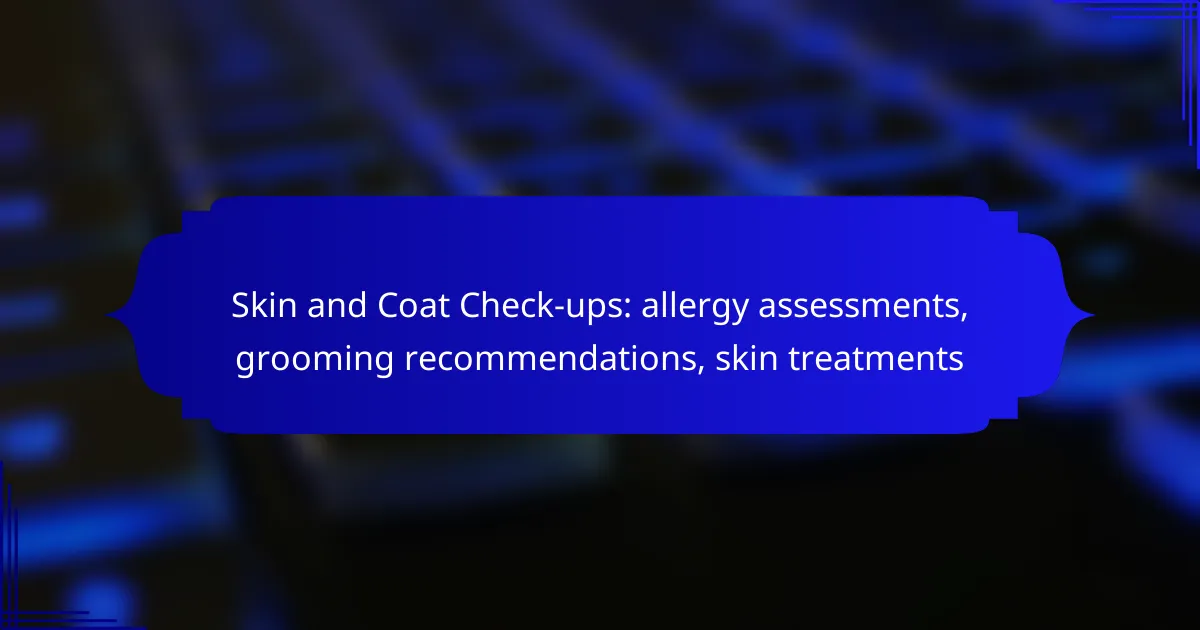Skin and coat check-ups are vital for ensuring the health and happiness of your pets, allowing for early detection of allergies and other skin issues. Regular assessments not only enhance coat health but also contribute to your pet’s overall well-being. By identifying allergens and following essential grooming recommendations, you can take proactive steps to maintain your furry friend’s skin and coat in optimal condition.

What are the key benefits of skin and coat check-ups in Australia?
Skin and coat check-ups in Australia provide essential benefits such as early detection of allergies, improved coat health, and enhanced overall well-being for pets. Regular assessments can help identify issues before they escalate, ensuring a healthier and happier life for your furry companions.
Early detection of allergies
Early detection of allergies during skin and coat check-ups allows for timely intervention and treatment. Common allergens in Australia include pollen, dust mites, and certain food ingredients, which can lead to skin irritations and discomfort for pets.
Veterinarians can perform allergy tests to pinpoint specific triggers, enabling pet owners to adjust diets or environments accordingly. This proactive approach can significantly reduce the risk of severe allergic reactions and chronic skin conditions.
Improved coat health
Regular grooming and skin assessments contribute to improved coat health by removing dirt, dead hair, and parasites. A healthy coat is not only aesthetically pleasing but also serves as a protective barrier against environmental factors.
In Australia, grooming recommendations often include using specific shampoos and conditioners suited to the pet’s coat type. Regular check-ups can help identify any skin issues that may require specialized treatments, ensuring the coat remains vibrant and healthy.
Enhanced overall well-being
Skin and coat check-ups play a vital role in enhancing the overall well-being of pets. Healthy skin and fur contribute to a pet’s comfort, reducing scratching and irritation that can lead to stress and behavioral issues.
Moreover, regular veterinary visits can help monitor a pet’s weight and nutrition, which are closely linked to skin health. Pet owners in Australia should aim for annual check-ups to maintain their pets’ health and address any emerging concerns promptly.

How can allergy assessments improve pet health?
Allergy assessments are crucial for enhancing pet health by identifying specific allergens that may cause discomfort or health issues. By understanding what triggers allergic reactions, pet owners can take proactive steps to mitigate these effects and improve their pet’s overall well-being.
Identification of allergens
Identifying allergens involves a thorough evaluation of your pet’s environment and diet. Common allergens include pollen, dust mites, certain foods, and flea saliva. A veterinarian may recommend skin tests or blood tests to pinpoint the exact substances causing the allergic reactions.
Pet owners should observe their pets for signs of allergies, such as excessive scratching, licking, or skin irritations. Keeping a diary of symptoms and potential triggers can aid veterinarians in making accurate diagnoses.
Customized treatment plans
Once allergens are identified, veterinarians can create customized treatment plans tailored to each pet’s needs. These plans may include allergy medications, dietary changes, or immunotherapy to gradually desensitize pets to specific allergens.
Regular follow-ups are essential to monitor the effectiveness of the treatment and make adjustments as necessary. Pet owners should adhere to the prescribed regimen and report any changes in their pet’s condition to ensure optimal health outcomes.

What grooming recommendations are essential for healthy skin and coat?
Essential grooming recommendations for maintaining healthy skin and coat include regular brushing, selecting appropriate grooming products, and following a consistent grooming schedule. These practices help prevent matting, reduce shedding, and promote overall skin health.
Regular brushing techniques
Regular brushing is crucial for removing loose fur, dirt, and debris, which can irritate the skin. Depending on the coat type, brushing should occur at least once a week, with more frequent sessions for long-haired breeds. Use a brush that suits your pet’s coat texture to avoid skin damage.
For dogs with thick or curly coats, consider using a slicker brush or a comb designed for detangling. For short-haired breeds, a bristle brush or rubber grooming mitt can effectively remove loose hair while stimulating the skin’s natural oils.
Recommended grooming products
Selecting the right grooming products is vital for maintaining skin and coat health. Look for shampoos and conditioners that are free from harsh chemicals and tailored to your pet’s specific skin type, such as sensitive or dry skin formulas. Natural ingredients like oatmeal or aloe vera can soothe irritation.
Additionally, consider using grooming sprays or wipes that help with tangles and add shine. Regularly check for any signs of skin allergies or irritations, and consult with a veterinarian if you notice any adverse reactions to grooming products.

What skin treatments are available for pets?
Various skin treatments for pets include topical treatments and oral medications, each designed to address specific skin issues. Understanding these options can help pet owners choose the most effective approach for their furry companions.
Topical treatments
Topical treatments are applied directly to the skin and can include creams, ointments, and sprays. These products often contain active ingredients that target specific conditions such as allergies, infections, or irritations.
Common topical treatments include hydrocortisone for inflammation, antifungal creams for yeast infections, and medicated shampoos for general skin health. Regular application as directed by a veterinarian is crucial for effectiveness.
When using topical treatments, ensure the area is clean and dry before application. Monitor your pet for any adverse reactions, and consult your vet if you notice increased irritation or discomfort.
Oral medications
Oral medications are often prescribed for more systemic skin issues or severe allergies. These can include antihistamines, corticosteroids, and antibiotics, depending on the underlying problem.
For instance, antihistamines can help alleviate allergic reactions, while corticosteroids may reduce inflammation. It’s essential to follow your veterinarian’s dosage recommendations to avoid potential side effects.
Keep in mind that oral medications may take time to show results, and regular follow-up with your vet can help adjust treatment as needed. Always inform your vet about any other medications your pet is taking to prevent interactions.

How often should pets have skin and coat check-ups?
Pets should generally have skin and coat check-ups at least twice a year to ensure their skin health and coat condition are optimal. Regular assessments help identify potential allergies, grooming needs, and skin treatments early on, preventing more serious issues.
Every six months
Scheduling skin and coat check-ups every six months is a standard recommendation for most pets. This frequency allows veterinarians to monitor any changes in skin condition, coat quality, and overall health. Regular visits can help catch allergies or skin infections before they escalate.
During these check-ups, grooming recommendations may also be provided based on the pet’s breed and coat type. For example, long-haired breeds may require more frequent grooming to prevent matting and skin irritation.
As needed based on symptoms
In addition to regular check-ups, pets should be evaluated as needed based on specific symptoms. Signs such as excessive scratching, hair loss, or skin redness warrant immediate attention. These symptoms can indicate allergies, infections, or other underlying health issues that require prompt treatment.
Pet owners should monitor their animals closely and seek veterinary advice if they notice any unusual behaviors or changes in their skin and coat. Early intervention can lead to more effective treatments and a quicker recovery for the pet.

What are the signs of skin allergies in pets?
Signs of skin allergies in pets often include itching, redness, and irritation. These symptoms can vary in severity and may indicate an allergic reaction to food, environmental factors, or parasites.
Excessive scratching
Excessive scratching is a primary indicator of skin allergies in pets. When a pet scratches more than usual, it may be trying to relieve discomfort caused by allergens. This behavior can lead to further skin damage and infections if not addressed promptly.
To assess scratching, observe your pet’s behavior throughout the day. If they are scratching frequently, especially in specific areas, it may be time to consult a veterinarian for an allergy assessment.
Red or inflamed skin
Red or inflamed skin is another common sign of skin allergies. This condition often occurs due to irritation from allergens, leading to inflammation and discomfort. The affected areas may appear swollen or warm to the touch.
Monitor your pet for any changes in skin color or texture. If you notice persistent redness or swelling, seek veterinary advice for appropriate skin treatments and grooming recommendations to alleviate your pet’s discomfort.

How do I choose a veterinarian for skin and coat check-ups?
To choose a veterinarian for skin and coat check-ups, prioritize their qualifications, experience, and client feedback. A skilled vet will have the expertise to assess allergies, recommend grooming, and provide effective skin treatments.
Check qualifications and experience
Start by verifying the veterinarian’s credentials, including their education and any specialized training in dermatology or skin conditions. Look for certifications from recognized veterinary associations, which indicate a commitment to ongoing education and best practices.
Experience matters significantly in skin and coat assessments. A veterinarian with several years in practice, particularly in dermatology, is likely to have encountered a wide range of skin issues and can provide more accurate diagnoses and treatment plans.
Read client reviews
Client reviews can offer valuable insights into a veterinarian’s approach and effectiveness. Look for feedback on their ability to handle skin and coat issues, as well as their communication style and the overall experience of pet owners.
Check platforms like Google Reviews or local veterinary directories to gather a range of opinions. Pay attention to recurring themes in the reviews, such as satisfaction with treatment outcomes or the vet’s attentiveness during consultations.

What are the costs associated with skin and coat check-ups?
The costs for skin and coat check-ups can vary widely based on location, the complexity of the assessment, and the specific treatments required. Generally, you can expect to pay anywhere from $50 to $200 for a basic check-up, while additional tests or treatments may increase the total cost.
Allergy assessments
Allergy assessments typically involve skin tests or blood tests to identify allergens affecting your pet. The costs for these assessments can range from $100 to $300, depending on the type of test and the number of allergens being tested.
When considering allergy assessments, it’s essential to consult with a veterinarian who can recommend the most appropriate tests based on your pet’s symptoms. Be aware that follow-up treatments, such as allergy shots or medication, may incur additional costs.
Grooming recommendations
Grooming recommendations are crucial for maintaining your pet’s skin and coat health. Regular grooming can help prevent skin issues and reduce the risk of allergies. Basic grooming services can range from $30 to $100, depending on the breed and size of your pet.
Consider scheduling grooming sessions every 4 to 8 weeks, especially for long-haired breeds. Additionally, ask your groomer about specific products that may benefit your pet’s skin condition, as some shampoos and conditioners can be more effective than others.
Skin treatments
Skin treatments can vary significantly in cost based on the type of treatment needed. Simple topical treatments may cost around $20 to $50, while more advanced therapies, such as laser treatments or specialized medications, can range from $100 to $500.
Before starting any skin treatment, discuss the options with your veterinarian to determine the most effective and cost-efficient approach for your pet’s specific condition. Regular follow-ups may be necessary to monitor progress and adjust treatments as needed.
